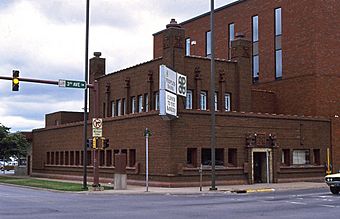Peoples Savings Bank facts for kids
Quick facts for kids |
|
|
People's Savings Bank
|
|
|
U.S. Historic district
Contributing property |
|
 |
|
| Location | 101 3rd Avenue, SW Cedar Rapids, Iowa |
|---|---|
| Built | 1911 |
| Architect | Louis Sullivan |
| Architectural style | Late 19th and Early 20th Century American Movements |
| Part of | West Side Third Avenue SW Commercial Historic District (ID14000323) |
| NRHP reference No. | 78001241 |
| Added to NRHP | March 29, 1978 |
The Peoples Savings Bank in Cedar Rapids, Iowa, is a special building designed by a famous architect named Louis Sullivan. It was one of several small, beautiful banks he designed in towns across the Midwest between 1907 and 1919. These banks are often called "jewel box" banks because they are small but very detailed and unique, like a precious jewel. This bank was built in 1911. In 1978, it was added to the National Register of Historic Places, which is a list of important historical sites in the United States. Later, in 2014, it became a part of the West Side Third Avenue SW Commercial Historic District, meaning it's an important building within a larger historical area.
Contents
Designing a Unique Bank
Louis Sullivan first drew up plans for the bank in the summer of 1909. However, the bank thought his first design was too expensive. The next year, the bank's leaders in Cedar Rapids, especially Vice-President Fred Shaver, kept talking with Sullivan. They finally agreed on a new plan.
Sullivan started designing the bank by focusing on the main banking room inside. He then worked outwards from there. He also found ways to lower the cost by using less fancy terra cotta (a type of baked clay decoration) on the outside. The building was finished in 1912.
A well-known architecture expert named Montgomery Schuyler once said that the bank was "designed from within outward." This means that the inside of the building was planned first, and then the outside was built to fit that inner design in a very simple way.
Special Details and Art
The bricks used for the outside of the bank came in 15 different shades. Sullivan said this made the building look like an "antique Oriental rug," which means it had a rich, varied color and texture.
Inside the bank, there are special high windows called clerestory walls that let in light. These walls have beautiful paintings, called murals, by an artist named Allen Philbrick. These murals show scenes of life in the countryside of Iowa.
This bank was the last project that George Grant Elmslie helped Louis Sullivan with. Soon after the bank was finished, Elmslie joined another architecture firm.
Bank Changes and the Flood
Around 1989, a company from Minneapolis called Norwest Corporation bought Peoples Bank. A few years later, Norwest bought another big bank called Wells Fargo and started using the Wells Fargo name. The building on Third Avenue kept being the main Wells Fargo branch for the Cedar Rapids area.
However, the bank is located close to the Cedar River. Because of this, it was affected by the Great Iowa Flood of 2008. The main bank building had to close because of the flood. Even though the main building was closed, the drive-through bank next to it was still open for customers.
Other "Jewel Box" Banks by Louis Sullivan
Louis Sullivan designed several other small, unique banks, often called "jewel boxes," across the Midwest. Here are some of them:
- Farmers and Merchants Bank in Columbus, Wisconsin (1919)
- Henry Adams Building in Algona, Iowa (1913)
- Home Building Association Company in Newark, Ohio (1914)
- Merchants' National Bank in Grinnell, Iowa (1914)
- National Farmer's Bank in Owatonna, Minnesota (1908)
- People's Federal Savings and Loan Association in Sidney, Ohio (1918)
- Purdue State Bank in West Lafayette, Indiana (1914)
Images for kids





